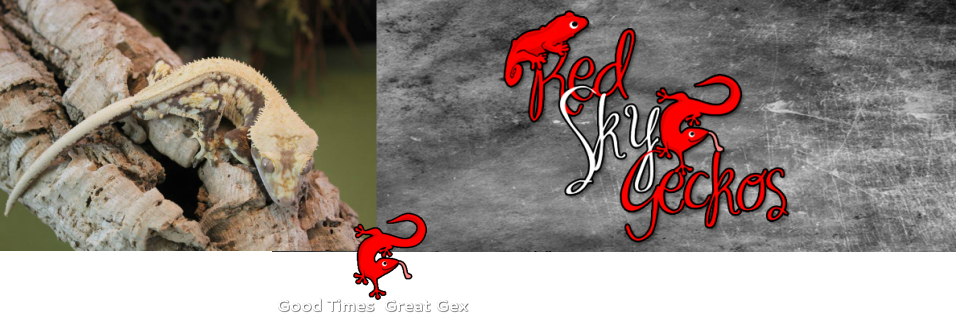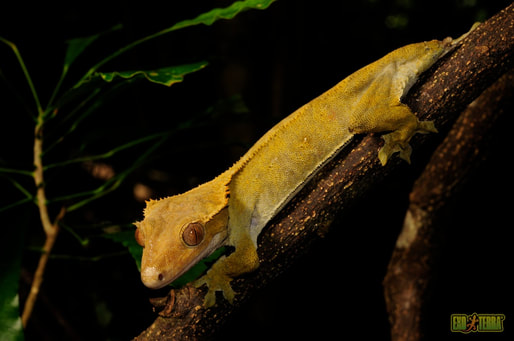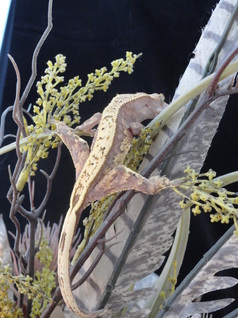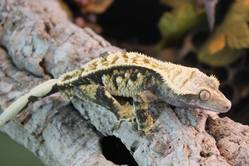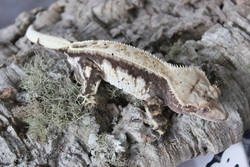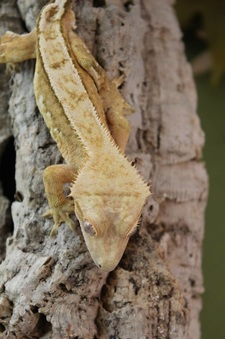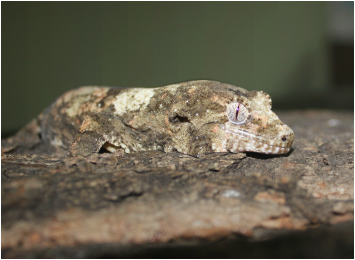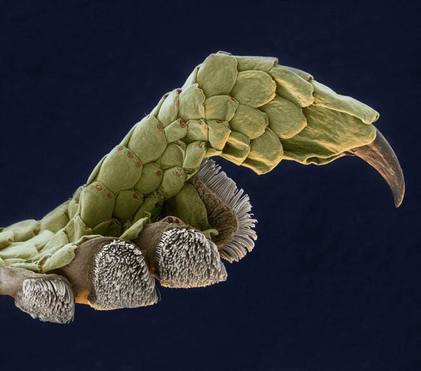Handy Things to Know About New Caledonian Geckos
- Crested Geckos can lick their own eyeballs. True story.
- This is useful because they do not have eyelids-meaning they cannot blink or close their eyes. They recess their eyes when they sleep.
- The sticky feet phenomenon is caused by hundreds of tiny hairs on the bottom of the feet using a tiny bit of moisture to get close enough to the surface of a wall or other object that van der Waals force kicks in and creates an electromagnetic field that attracts rather than repels.
- Crested Geckos and other geckos from New Caledonia can change colors using photoreceptors to gauge light from shadow and also by determining the amount of humidity in the air. When a gecko is at it’s darkest, or night-time, color we call it “firing up”.
- Crested geckos are Ninja shedders. They will shed at night, often in one big piece like taking off pajamas, and then they will eat it.
- It is thought that Crested Geckos can see UV. They have excellent vision in general but in lower light situations since they are crepuscular.
- Female Crested Geckos make a squeaky “nah, nah, nah” noise and shake their heads when they do not want to be touched by another gecko or human.
- Female Crested Geckos can lay infertile eggs just like a chicken. They typically lay during the warm months.
- Female Crested Geckos can lay fertile eggs for up to a year after being fertilized by a male. (By the way, male Crested Geckos have 2 hemipenes)
- When a Crested Gecko drops it’s tail it does not grow back. It uses a muscle in the back of the body to release the tail and grabs it by a back foot, takes it off and then throws it while it runs the other direction. Tails can continue to move for 10 minutes.
Scroll down for more information including videos of geckos in the wild!
The Exo Terra expedition to New Caledonia offers some great shots of Crested Geckos and Chahouas in the wild. http://correlophus.blogspot.com has more shots like the one above of Crested Geckos in the wild. Interesting to note that most were yellow-brown patternless and did not have tails. Watch the video below for short history of C. Cilatus and some interesting footage of Crested Geckos in the wild.
Keep scrolling down for more information about geckos and New Caledonia!
|
Crested Geckos, also known as Eyelash Geckos or by their Latin name: Rhacodactylus Ciliatus (changed in 2012 to Correlophus Ciliatus), were first discovered in the 1800's in the islands of New Caledonia in the Coral Sea. Thought to be extinct, they were re-discovered on the Isle of Pines after a hurricane in 1994. A limited number were taken out of the country between 1994-1996 and for the most part the thousands in captivity today are descendants of these original geckos. Breeders have been fascinated by them because of their ability to produce a wide range of colors and patterns as well as their ability to breed in captivity. The first Crested Geckos did not have the colors and patterns we see in the pet trade today. Many colors and patterns are a product of selective breeding. They are now one of the most widely kept reptiles in captivity. Part of their popularity is due to their easy adaptation to our house temperatures, hardiness, handleability, and ease of care. Today the exportation of wild Crested Geckos is illegal in New Caledonia and they are threatened by imported rats and ants in their native environment. Crested Geckos are not considered an invasive species in the U.S. as they cannot tolerate excessive heat, cold, or lack of humidity. They also have few defenses against predators and would be prey to most creatures encountered in the wild. Crested geckos are nocturnal and arboreal. They have lamillae on their feet and the ends of their tails-this allows them to use water droplets to create a bond with surfaces. In other words, they climb and stick to things (kind of like Spiderman). Their tails are semi prehensile and can be used to help them cling to things like branches (or fingers) when jumping. They have a sticky pad at the end of the tail as well. As adults it is for common for the gecko to have a 'frog-butt' or a stub tail because the longer tail of youth has been shed. They no longer need the tail as adults and can throw the tail at will-usually due to some environmental stress but not always-and it does not grow back. Their diet in the wild consists of insects and fruit. |
|
Chahouas, also called Chewies, Mossy (New Caledonian or Short-snouted) Geckos or Rhacodactylus Chahoua (changed in 2012 to Mnairogekko Chahoua) is arboreal and nocturnal similar to the Crested Gecko. Like other geckos they have prehensile tails and lamillae on their feet. They are native to the southern portion of New Caledonia and on the outlying islands of Ile de Pines and Grande. The name 'mossy' describes the moss or lichen camouflage pattern that the gecko imitates in order to blend into rocks and trees. Colors change dramatically as the gecko ages. Young Chahoua typically have brown, black, white, with areas of red toned color (including peach and pink) in some cases. As they age the red tones typically seem to spread as the brown and white areas change to these colors. The earth tones also turn to shades of green and often retain a lacy pattern. The snout to vent length averages 5.5 inches and the weight ranges from 60-90 grams. Their diet in the wild consists of insects and fruit. |
Above: New Caledonia is an Island in the Coral Sea. It is a temperate rain forest and home to many species of geckos.
Below: Pine Island, Ile des Pins is a small island off of New Caledonia. The Pine Island M. Chahoua comes from this area.
More information about New Caledonia: https://en.wikipedia.org/wiki/Biodiversity_of_New_Caledonia
|
|
Rhacodactylus Leachianus or Leachies, are the largest of the gecko species. They are nocturnal but are known to come out and bask as well. They are also found on New Caledonia as well as the smaller islands and are predators of the smaller gecko species on the island. They eat fruit and insects as well and can eat the packaged Crested Gecko Diet with some modifications for extra protein and fresh fruit. They are handleable but not as tolerant as Crested Geckos and Chahoua. They tend to be cage aggressive and territorial. They are best kept by themselves in a larger enclosure than required for the other species. Since they are arboreal they require vertical space to climb and hide. They prefer logs and cork rounds to leaves and greenery as they typically live in tree hollows. They are vocal and can bark, hiss and growl. Locally they are known as the "Devil in the Trees". One of their favorite tricks is to shoot excrement at would-be handlers.
|
|
Click the link for a video of Frank Fast and Philippe DeVosjoli in New Caledonia in 1994. Video by Frank Fast. The quality is very 1990's home-movie and there is a lot of seemingly aimless wandering around-geckos are only shown at the 36 minute mark. But if you are a true gecko fan and want to get a feel for the island habitat and see this historic adventure then it is worth a look. Couple of interesting points-Frank Fast mentions owl being on the islands and at one point we can hear what sounds like crows.
